This is a list of American electoral candidates for the offices of President of the United States and Vice President of the United States of the modern Democratic Party, either duly preselected and nominated, or the presumptive nominees of a future preselection and election. Opponents who received over one percent of the popular vote or ran an official campaign that received Electoral College votes are listed. Offices held prior to Election Day are included, and those held on Election Day have an italicized end date.
19th century
1828, 1832
| Presidential nominee |
1828 (won), 1832 (won) | Vice presidential nominee | |
|---|---|---|---|
| Andrew Jackson of TN (1767–1845) 
|
|
|
John C. Calhoun of SC (1782–1850)  (1828) |
|
Martin Van Buren of NY (1782–1862)  (1832) | ||
| Opponent(s) John Quincy Adams (National Republican) |
|
Opponent(s) Richard Rush (National Republican) | |
| Opponent(s) Henry Clay (Whig) William Wirt (Anti-Masonic) |
|
Opponent(s) John Sergeant (Whig) Amos Ellmaker (Anti-Masonic) | |
1836, 1840
| Presidential nominee |
1836 (won), 1840 (lost) | Vice presidential nominee | |
|---|---|---|---|
| Martin Van Buren of NY (1782–1862) 
|
|
|
Richard Johnson of KY (1780–1850) 
|
| Opponent(s) William Harrison (Northern Whig) Hugh White (Southern Whig) |
|
Opponent(s) Francis Granger (Northern Whig) John Tyler (Southern Whig) | |
| Opponent(s) William Harrison (Whig) |
|
Opponent(s) John Tyler (Whig) | |
1844
| Presidential nominee |
1844 (won) | Vice presidential nominee | |
|---|---|---|---|
| James Polk of TN (1795–1849) 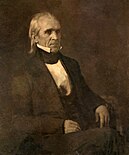
|
|
|
Silas Wright of NY (1795–1847) 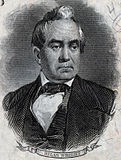 (1844) |
|
George Dallas of PA (1792–1864)  (1844) | ||
| Opponent(s) Henry Clay (Whig) James Birney (Liberty) |
|
Opponent(s) Theodore Frelinghuysen (Whig) Thomas Morris (Liberty) | |
1848
| Presidential nominee |
1848 (lost) | Vice presidential nominee | |
|---|---|---|---|
| Lewis Cass of MI (1782–1866) 
|
|
|
William Butler of KY (1791–1880) 
|
| Opponent(s) Zachary Taylor (Whig) Martin Van Buren (Free Soil) |
|
Opponent(s) Millard Fillmore (Whig) Charles Adams (Free Soil) | |
1852
| Presidential nominee |
1852 (won) | Vice presidential nominee | |
|---|---|---|---|
| Franklin Pierce of NH (1804–1869) 
|
|
|
William King of AL (1786–1853) 
|
| Opponent(s) Winfield Scott (Whig) John Hale (Free Soil) |
|
Opponent(s) William Graham (Whig) George Julian (Free Soil) | |
1856
| Presidential nominee |
1856 (won) | Vice presidential nominee | |
|---|---|---|---|
| James Buchanan of PA (1791–1868) 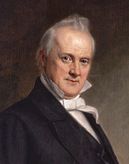
|
|
|
John Breckinridge of KY (1821–1875) 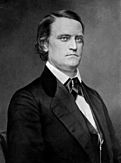
|
| Opponent(s) John Frémont (Republican) Millard Fillmore (Know Nothing) |
|
Opponent(s) William Dayton (Republican) Andrew Donelson (Know Nothing) | |
1860
| Presidential nominee |
1860 (lost) | Vice presidential nominee | |
|---|---|---|---|
| Stephen Douglas of IL (1813–1861) 
|
|
|
Herschel Johnson of GA (1812–1880) 
|
| Opponent(s) Abraham Lincoln (Republican) John Breckinridge (Southern Democrats) John Bell (Constitutional Union) |
|
Opponent(s) Hannibal Hamlin (Republican) Joe Lane (Southern Democrats) Edward Everett (Constitutional Union) | |
1864
| Presidential nominee |
1864 (lost) | Vice presidential nominee | |
|---|---|---|---|
| George McClellan of NJ (1826–1885) 
|
|
|
George Pendleton of OH (1825–1889) 
|
| Opponent(s) Abraham Lincoln (National Union) |
|
Opponent(s) Andrew Johnson (National Union) | |
1868
| Presidential nominee |
1868 (lost) | Vice presidential nominee | |
|---|---|---|---|
| Horatio Seymour of NY (1810–1886) 
|
|
|
Francis Blair of MO (1821–1875) 
|
| Opponent(s) Ulysses S. Grant (Republican) |
|
Opponent(s) Schuyler Colfax (Republican) | |
1872
| Presidential nominee |
1872 (lost) | Vice presidential nominee | |
|---|---|---|---|
| Horace Greeley of NY (1811–1872) 
|
|
|
Gratz Brown of MO (1826–1885) 
|
| Opponent(s) Ulysses S. Grant (Republican) |
|
Opponent(s) Henry Wilson (Republican) | |
1876
| Presidential nominee |
1876 (lost) | Vice presidential nominee | |
|---|---|---|---|
| Samuel Tilden of NY (1814–1886) 
|
|
|
Thomas Hendricks of IN (1819–1885) 
|
| Opponent(s) Rutherford Hayes (Republican) |
|
Opponent(s) William Wheeler (Republican) | |
1880
| Presidential nominee |
1880 (lost) | Vice presidential nominee | |
|---|---|---|---|
| Winfield Hancock of PA (1824–1886) 
|
|
|
William English of IN (1822–1896) 
|
| Opponent(s) James Garfield (Republican) James Weaver (Greenback) |
|
Opponent(s) Chester Arthur (Republican) Barzillai Chambers (Greenback) | |
1884, 1888, 1892
| Presidential nominee |
1884 (won), 1888 (lost), 1892 (won) | Vice presidential nominee | |
|---|---|---|---|
| Grover Cleveland of NY (1837–1908) 
|
|
|
Thomas Hendricks of IN (1819–1885)  (1884) |
|
Allen Thurman of OH (1813–1895)  (1888) | ||
|
Adlai Stevenson of IL (1835–1914)  (1892) | ||
| Opponent(s) James Blaine (Republican) St. John (Prohibition) Benjamin Butler (Greenback) |
|
Opponent(s) John Logan (Republican) William Daniel (Prohibition) Absolom West (Greenback) | |
| Opponent(s) Benjamin Harrison (Republican) Clinton Fisk (Prohibition) Alson Streeter (Union Labor) |
|
Opponent(s) Levi Morton (Republican) John Brooks (Prohibition) Charles Cunningham (Union Labor) | |
| Opponent(s) Benjamin Harrison (Republican) James Weaver (Populist) John Bidwell (Prohibition) |
|
Opponent(s) Whitelaw Reid (Republican) James Field (Populist) James Cranfill (Prohibition) | |
1896, 1900
| Presidential nominee |
1896 (lost), 1900 (lost) | Vice presidential nominee | |
|---|---|---|---|
| William Jennings Bryan of NE (1860–1925) 
|
|
|
Arthur Sewall of ME (1835–1900)  (1896) |
|
Adlai Stevenson of IL (1835–1914)  (1900) | ||
| Opponent(s) William McKinley (Republican) |
|
Opponent(s) Garret Hobart (Republican) Thomas E. Watson (Populist) | |
| Opponent(s) William McKinley (Republican) John Woolley (Prohibition) |
|
Opponent(s) Theodore Roosevelt (Republican) Henry Metcalf (Prohibition) | |
20th century
1904
| Presidential nominee |
1904 (lost) | Vice presidential nominee | |
|---|---|---|---|
| Alton Parker of NY (1852–1926) 
|
|
|
Henry Davis of WV (1823–1916) 
|
| Opponent(s) Theodore Roosevelt (Republican) Gene Debs (Socialist) Silas Swallow (Prohibition) |
|
Opponent(s) Charles Fairbanks (Republican) Ben Hanford (Socialist) George Carroll (Prohibition) | |
1908
| Presidential nominee |
1908 (lost) | Vice presidential nominee | |
|---|---|---|---|
| William Jennings Bryan of NE (1860–1925) 
|
|
|
John Kern of IN (1849–1917) 
|
| Opponent(s) William Taft (Republican) Gene Debs (Socialist) Eugene Chafin (Prohibition) |
|
Opponent(s) Jim Sherman (Republican) Ben Hanford (Socialist) Aaron Watkins (Prohibition) | |
1912, 1916
| Presidential nominee |
1912 (won), 1916 (won) | Vice presidential nominee | |
|---|---|---|---|
| Woodrow Wilson of NJ (1856–1924) 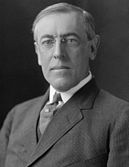
|
|
|
Thomas Marshall of IN (1854–1925) 
|
| Opponent(s) William Taft (Republican) Theodore Roosevelt (Progressive) Gene Debs (Socialist) Eugene Chafin (Prohibition) |
|
Opponent(s) Nicholas Butler (Republican) Hiram Johnson (Progressive) Emil Seidel (Socialist) Aaron Watkins (Prohibition) | |
| Opponent(s) Charles Hughes (Republican) Allan Benson (Socialist) Frank Hanly (Prohibition) |
|
Opponent(s) Charles Fairbanks (Republican) Kirk Kirkpatrick (Socialist) Ira Landrith (Prohibition) | |
1920
| Presidential nominee |
1920 (lost) | Vice presidential nominee | |
|---|---|---|---|
| James Cox of OH (1870–1957) 
|
|
|
Franklin D. Roosevelt of NY (1882–1945) 
|
| Opponent(s) Warren G. Harding (Republican) Gene Debs (Socialist) Parley Christensen (Farmer-Labor) |
|
Opponent(s) Calvin Coolidge (Republican) Stedy Stedman (Socialist) Max Hayes (Farmer-Labor) | |
1924
| Presidential nominee |
1924 (lost) | Vice presidential nominee | |
|---|---|---|---|
| John Davis of WV (1873–1955) 
|
|
|
Charles Bryan of NE (1867–1945) 
|
| Opponent(s) Calvin Coolidge (Republican) Robert La Follette (Progressive) |
|
Opponent(s) Charles Dawes (Republican) Burton Wheeler (Progressive) | |
1928
| Presidential nominee |
1928 (lost) | Vice presidential nominee | |
|---|---|---|---|
| Al Smith of NY (1873–1944) 
|
|
|
Joe Robinson of AR (1872–1937) 
|
| Opponent(s) Herbert Hoover (Republican) |
|
Opponent(s) Charles Curtis (Republican) | |
1932, 1936, 1940, 1944
| Presidential nominee |
1932 (won), 1936 (won), 1940 (won), 1944 (won) | Vice presidential nominee | |
|---|---|---|---|
| Franklin D. Roosevelt of NY (1882–1945) 
|
|
|
Jack Garner of TX (1868–1967)  (1932, 1936) |
|
Henry Wallace of IA (1888–1965)  (1940) | ||
|
Harry S. Truman of MO (1884–1972) 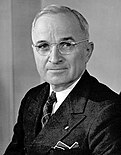 (1944) | ||
| Opponent(s) Herbert Hoover (Republican) Norman Thomas (Socialist) |
|
Opponent(s) Charles Curtis (Republican) James Maurer (Socialist) | |
| Opponent(s) Alf Landon (Republican) William Lemke (Union) |
|
Opponent(s) Frank Knox (Republican) Thomas O'Brien (Union) | |
| Opponent(s) Wendell Willkie (Republican) |
|
Opponent(s) Charles L. McNary (Republican) | |
| Opponent(s) Thomas Dewey (Republican) |
|
Opponent(s) John Bricker (Republican) | |
1948
| Presidential nominee |
1948 (won) | Vice presidential nominee | |
|---|---|---|---|
| Harry S. Truman of MO (1884–1972) 
|
|
|
Alben Barkley of KY (1877–1956) 
|
| Opponent(s) Thomas Dewey (Republican) Strom Thurmond (Dixiecrat) Henry Wallace (Progressive) |
|
Opponent(s) Earl Warren (Republican) Fielding Wright (Dixiecrat) Glen Taylor (Progressive) | |
1952, 1956
| Presidential nominee |
1952 (lost), 1956 (lost) | Vice presidential nominee | |
|---|---|---|---|
| Adlai Stevenson II of IL (1900–1965) 
|
|
|
John Sparkman of AL (1899–1985)  (1952) |
|
Estes Kefauver of TN (1903–1963)  (1956) | ||
| Opponent(s) Dwight D. Eisenhower (Republican) |
|
Opponent(s) Richard Nixon (Republican) | |
| |||
1960
| Presidential nominee |
1960 (won) | Vice presidential nominee | |
|---|---|---|---|
| John F. Kennedy of MA (1917–1963) 
|
|
|
Lyndon B. Johnson of TX (1908–1973) 
|
| Opponent(s) Richard Nixon (Republican) Harry F. Byrd (Southern Democrats) |
|
Opponent(s) Henry Cabot Lodge Jr. (Republican) Strom Thurmond (Southern Democrats) | |
1964
| Presidential nominee |
1964 (won) | Vice presidential nominee | |
|---|---|---|---|
| Lyndon B. Johnson of TX (1908–1973) 
|
|
|
Hubert Humphrey of MN (1911–1978) 
|
| Opponent(s) Barry Goldwater (Republican) |
|
Opponent(s) William E. Miller (Republican) | |
1968
| Presidential nominee |
1968 (lost) | Vice presidential nominee | |
|---|---|---|---|
| Hubert Humphrey of MN (1911–1978) 
|
|
|
Edmund Muskie of ME (1914–1996)  |
| Opponent(s) Richard Nixon (Republican) George Wallace (American Independent) |
|
Opponent(s) Spiro Agnew (Republican) Curtis LeMay (American Independent) | |
1972
| Presidential nominee |
1972 (lost) | Vice presidential nominee | |
|---|---|---|---|
| George McGovern of SD (1922–2012) 
|
|
|
Tom Eagleton of MO (1929–2007)  (1972) |
|
Sargent Shriver of MD (1915–2011)  (1972) | ||
| Opponent(s) Richard Nixon (Republican) John G. Schmitz (American Independent) |
|
Opponent(s) Spiro Agnew (Republican) Thomas J. Anderson (American Independent) | |
1976, 1980
| Presidential nominee |
1976 (won), 1980 (lost) | Vice presidential nominee | |
|---|---|---|---|
| Jimmy Carter of GA (1924–2024) 
|
|
|
Walter Mondale of MN (1928–2021) 
|
| Opponent(s) Gerald Ford (Republican) |
|
Opponent(s) Bob Dole (Republican) | |
| Opponent(s) Ronald Reagan (Republican) John B. Anderson (Independent) Ed Clark (Libertarian) |
|
Opponent(s) George H. W. Bush (Republican) Patrick Lucey (Independent) David Koch (Libertarian) | |
1984
| Presidential nominee |
1984 (lost) | Vice presidential nominee | |
|---|---|---|---|
| Walter Mondale of MN (1928–2021) 
|
|
|
Geraldine Ferraro of NY (1935–2011) 
|
| Opponent(s) Ronald Reagan (Republican) |
|
Opponent(s) George H. W. Bush (Republican) | |
1988
| Presidential nominee |
1988 (lost) | Vice presidential nominee | |
|---|---|---|---|
| Michael Dukakis of MA (born 1933) 
|
|
|
Lloyd Bentsen of TX (1921–2006) 
|
| Opponent(s) George H. W. Bush (Republican) |
|
Opponent(s) Dan Quayle (Republican) | |
1992, 1996
| Presidential nominee |
1992 (won), 1996 (won) | Vice presidential nominee | |
|---|---|---|---|
| Bill Clinton of AR (born 1946) 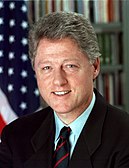
|
|
|
Al Gore of TN (born 1948) 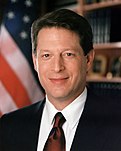
|
| Opponent(s) George H. W. Bush (Republican) Ross Perot (Independent) |
|
Opponent(s) Dan Quayle (Republican) James Stockdale (Independent) | |
| Opponent(s) Bob Dole (Republican) Ross Perot (Reform) |
|
Opponent(s) Jack Kemp (Republican) Pat Choate (Reform) | |
21st century
2000
| Presidential nominee |
2000 (lost) | Vice presidential nominee | |
|---|---|---|---|
| Al Gore of TN (born 1948) 
|
|
|
Joe Lieberman of CT (1942–2024) 
|
| Opponent(s) George W. Bush (Republican) Ralph Nader (Green) |
|
Opponent(s) Dick Cheney (Republican) Winona LaDuke (Green) | |
2004
| Presidential nominee |
2004 (lost) | Vice presidential nominee | |
|---|---|---|---|
| John Kerry of MA (born 1943) 
|
|
|
John Edwards of NC (born 1953) 
|
| Opponent(s) George W. Bush (Republican) |
|
Opponent(s) Dick Cheney (Republican) | |
2008, 2012
| Presidential nominee |
2008 (won), 2012 (won) | Vice presidential nominee | |
|---|---|---|---|
| Barack Obama of IL (born 1961) 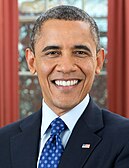
|
|
|
Joe Biden of DE (born 1942) 
|
| Opponent(s) John McCain (Republican) |
|
Opponent(s) Sarah Palin (Republican) | |
| Opponent(s) Mitt Romney (Republican) |
|
Opponent(s) Paul Ryan (Republican) | |
2016
| Presidential nominee |
2016 (lost) | Vice presidential nominee | |
|---|---|---|---|
| Hillary Clinton of NY (born 1947) 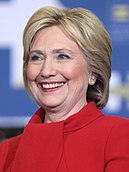
|
|
|
Tim Kaine of VA (born 1958) 
|
| Opponent(s) Donald Trump (Republican) Gary Johnson (Libertarian) Jill Stein (Green) |
|
Opponent(s) Mike Pence (Republican) Bill Weld (Libertarian) Ajamu Baraka (Green) | |
2020
| Presidential nominee |
2020 (won) | Vice presidential nominee | |
|---|---|---|---|
| Joe Biden of DE (born 1942) 
|
|
|
Kamala Harris of CA (born 1964) 
|
| Opponent(s) Donald Trump (Republican) Jo Jorgensen (Libertarian) |
|
Opponent(s) Mike Pence (Republican) Spike Cohen (Libertarian) | |
2024
| Presidential nominee |
2024 (lost) | Vice presidential nominee | |
|---|---|---|---|
| Kamala Harris of CA (born 1964) 
|
|
|
Tim Walz of MN (born 1964) 
|
| Opponent(s) Donald Trump (Republican) |
|
Opponent(s) JD Vance (Republican) | |
See also
- List of Democratic National Conventions
- History of the United States Democratic Party
- List of United States National Republican/Whig Party presidential tickets
- List of United States Republican Party presidential tickets
- List of United States Green Party presidential tickets
- List of United States Libertarian Party presidential tickets
- List of Federalist Party presidential tickets
- List of Democratic-Republican Party presidential tickets
- List of United States major third party and independent presidential tickets
- List of United States Democratic Party presidential candidates
Notes
- If not for unpledged electors, Rush would have won 178 (68.2%) votes.
- South Carolina's delegates were selected by the state legislature and not by popular vote, which went to the Nullifier ticket of Floyd/Lee, which did not campaign, while 30 Pennsylvania delegates voted Wilkins for vice president. Two Maryland delegates did not cast votes.
- The Whig Party ran regional candidates in 1836. William H. Harrison and Francis Granger ran in Northern states, while Hugh Lawson White and John Tyler ran in Southern states. Daniel Webster was on the ballot in Massachusetts and Willie Person Mangum received votes from the Electoral College without being on the ballot.
- Wright declined after being nominated by the convention.
- Douglas and Johnson were chosen at the national nominating convention after most of the Southern delegations walked out, who held a separate national nominating convention to nominate Breckinridge and Lane.
- If not for 17 invalidated electors from Union-occupied Louisiana and Tennessee, Lincoln and Johnson would have won 229 (91.6%) votes.
- If not for 17 invalidated electors from Union-occupied Louisiana and Tennessee, McClellan and Pendleton would have won 8.4% of the votes.
- If not for the 14 invalidated electors from voting irregularities in Arkansas and Louisiana, Grant and Wilson would have won 300 (82.0%) votes.
- Greeley died after the election but before the Electoral College convened, and was not replaced for the vote. The ticket's intended delegates were scattered.
- If not for the 14 invalidated electors for Grant and Wilson from voting irregularities in Arkansas and Louisiana, Greeley and Brown's 66 votes would have been 18.0%.
- If not for a faithless elector, Eisenhower and Nixon would have won 458 (86.3%) in 1956.
- Eagleton withdrew from the ticket and was replaced by Shriver.
- ^ If not for a faithless elector, Nixon and Agnew would have won 521 (96.8%) Electoral College votes.
- If not for a faithless elector, Ford would have won 241 (44.8%) votes.
- ^ A faithless elector swapped their votes for president and vice president in the Electoral College, otherwise the Dukakis/Bentsen ticket would have won 112 (20.8%) votes.
- An elector from the District of Columbia abstained from casting a vote for the Gore/Lieberman ticket, otherwise Gore would have won 267 (49.6%) votes.
- A faithless elector voted Edwards for president and vice president in the Electoral College, otherwise Kerry would have won 252 (46.8%) votes.
- If not for faithless electors, Trump and Pence would have won 306 (56.9%) Electoral College votes each, while Clinton and Kaine would have won 232 (43.1%) votes.
| Lists related to presidents and vice presidents of the United States | |||||
|---|---|---|---|---|---|
| Presidents | |||||
| Vice presidents | |||||
| Succession | |||||
| Elections | |||||
| Candidates |
| ||||